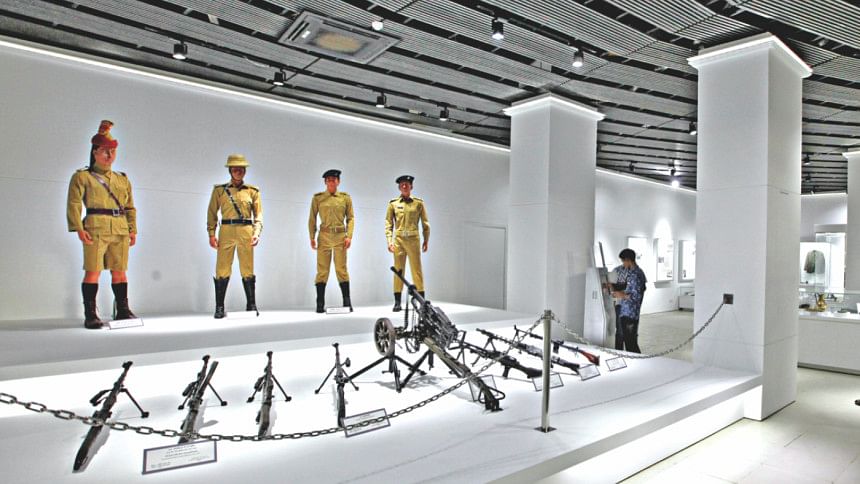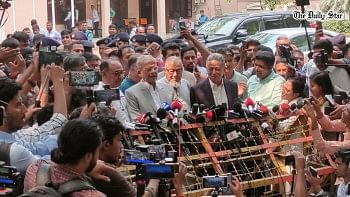Finding the brave souls

The night was darker than any other. On such a night, eight of the country's finest -- members of police force -- were safeguarding the country's image by protecting a foreign establishment.
Little did Khalil Miah and his seven other colleagues know that the military of their own country has unleashed a genocide campaign, termed Operation Searchlight, on that very night -- March 25 of 1971.
Khalil and the other seven policemen were martyred while protecting the British Council on Fuller Road that night as contingents of the Pakistan occupation forces rained bullets and heavy artillery on student dormitories and other establishments throughout the Dhaka University campus.
The Bangalees, in present Bangladesh, will always remember that night as the Black Night when the Pakistan forces massacred hundreds, including Bangalee members of police and paramilitary force, known as East Pakistan Rifles (EPR), on the campus of Dhaka University, and barracks of Rajarbagh Police Lines and Pilkhana EPR headquarters in Dhaka.
This year, 46 years after the massacre, the British Council sought the assistance of the Police Headquarters (PHQ) in finding the names of the eight fallen heroes of police, months before the unveiling of a memorial on its Fuller Road compound.
The council authorities had to open the memorial on July 27 without the names of the martyrs as the PHQ could not provide them with the names.
The police database was partially destroyed or lost during the Liberation War in 1971.
In mid-August, soon after the formal inception of Police Liberation War Museum (PLWM) Unit, its researchers succeeded in identifying Khalil Miah as one of the eight on-duty police members who died on the British Council premises.
The PHQ formally formed the PLWM unit earlier the same month to identify the fallen police heroes of 1971 and ensure their national recognition as well as welfare of their living family members.
The PLWM unit found out that Khalil, the first child of Amena Begum and Kala Miah from Mymensingh, joined the force as a constable in 1969 after finishing ninth grade in school. He was stationed at Rajarbagh Police Lines. According to a PHQ estimation, near about 1,100 police personnel sacrificed their lives during the Liberation War of 1971. Despite having no comprehensive database available from that period, 751 of them have so far been identified, said Abida Sultana, assistant inspector general (welfare) at PHQ, also the director of the newly-formed PLWM unit.
Khalil's nephew Sharif Hossain told The Daily Star that the bravery and memory of his uncle sank into oblivion after his grandmother (Khalil's mother) passed away in 2012. His grandfather died during Sharif's childhood.
“My uncle [Khalil] joined the force when my father and two other uncles were very young. All of them passed away a while ago. As a result, we couldn't learn much about him [Khalil],” said Sharif, adding that they had contacted the PHQ to find out about his uncle's deeds, but there were no details available about him.
IN QUEST OF FINDING THE HEROES
The effort to create a database of the fallen police members of 1971 was initiated five years back, in 2012.
Habibur Rahman, now an additional deputy inspector general at PHQ, along with several of his colleagues, unofficially launched the initiative to collect details of the police heroes.
In June 2013, they submitted a proposal seeking a formal research unit in police with necessary manpower to do the job more efficiently, Habibur told The Daily Star.
Their long-running quest to trace the martyrs finally received official support after their proposal was approved this year and the Police Liberation War Museum Unit was formed, he said with a tone of satisfaction.
The total number of manpower assigned to the PLWM unit is 18. The unit is headed by a director with the designation of superintendent of police (SP). An assistant superintendent of police (ASP) serves as its assistant director.
The other members of the unit include two sub-inspectors, two assistant sub-inspectors, four constables and eight office assistants.
Right before its formal inception, the PLWM unit identified 44 policemen who died fighting at the Rajarbagh Police Lines during the first armed resistance against the Pakistan army on the Black Night of March 25 in 1971.
The government accorded formal recognition to the 44 martyrs and disbursed financial assistance to their heirs, PLWM unit Director Abida Sultana told this correspondent.
Recently, “we have identified 34 other policemen who also took up arms [that night] at Rajarbagh and we sent their names to the [home] ministry for recognition,” she said, adding that the unit members will continue their search for the other heroes and ensure the welfare of their families.
The database, being updated by the PLWM unit, consisting details of the police members killed during the Liberation War will be preserved at the Bangladesh Police Liberation War Museum, which was inaugurated at the Rajarbagh Police Lines in January this year.
Aside from their primary task of research, the unit is making efforts to bolster the morale and dignity of new police recruits by disseminating information about supreme sacrifices their predecessors made during desperate times of the country, Abida said.

 For all latest news, follow The Daily Star's Google News channel.
For all latest news, follow The Daily Star's Google News channel. 



Comments